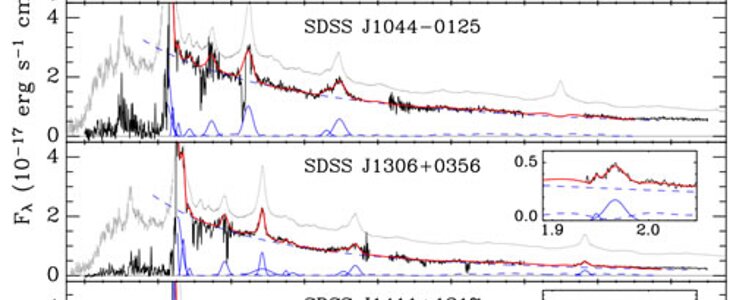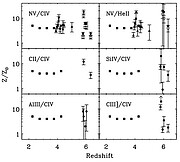Frenetic growth of supermassive black holes in the early universe
31 July 2007
Linhua Jiang (Steward Observatory, University of Arizona) has led a United States/Germany team of astronomers in the study of some of the most distant and youngest known quasars. The six distant quasars they observed are at redshifts ranging between z = 5.8 to 6.3 and correspond to a period when the universe was only about one billion years old. Using the Gemini Near Infrared Spectrograph (GNIRS) at Gemini South and the Near-Infrared Imager (NIRI) at Gemini North, the team found these very young quasars to be already super-enriched in heavy elements. The quasars are also powered by extremely massive black holes. The Jiang et al. results cast a new light on the assembly of black holes and the chemical enrichment of the universe less than one billion years after the Big Bang.
Quasars are the most luminous and most energetic objects in the universe. The stellar-like objects are surmised to be powered by radiation from matter accreting onto supermassive black holes at the center of host galaxies in the process of forming. Dense gas in the region surrounding the black hole moves at high velocities. It gives rise to a broad line region (BLR) in spectra that can be used as a diagnostic of several properties of the gas itself and of the central black hole.
Early Rapid Chemical Enrichment
Chemical abundances in the BLR are important in understanding the history of star formation in the host galaxy. In particular, the ratio of iron (Fe) to the oxygen family elements (such as oxygen, carbon and magnesium, also called the alpha elements) is expected to have a strong correlation to age in young systems. Oxygen is produced and ejected very quickly in massive stars, while iron (Fe) comes from long-lived intermediate-mass stars. Hence, most Fe enrichment happens about one billion years after the initial starburst.
Emission line ratios in the infrared spectrum of the quasars allow the measurement of gas metallicity in the quasar BLR (Figure 2). The abundances are found to be super-solar at Zquasar ~ 4 Zsun. The Fe II/Mg II ratio is important in understanding chemical evolution at high redshifts. Jiang et al. show that the metallicity in the BLRs of high redshift quasars is super-solar, and that there is no sign of strong evolution in metallicity between the local universe to z ~ 6 (Figure 3). The high metallicity found at this redshift indicates that vigorous star formation and fierce element enrichment have occurred in quasar host galaxies in the first billion years of cosmic time. This is consistent with other studies that have shown little chemical evolution up to the highest known redshift.
Central Black Holes Masses
The presence of very luminous high-redshift quasars in the early universe also betrays the rapid growth of black hole mass when the first generations of galaxies and quasars formed. The bulk motions of the broad-line region (BLR) are used to determine the mass of the central black hole.
Black hole mass is calculated using mass scaling relations based on emission line widths (broadened by the high velocity motions in the strong gravitational field) and continuum luminosities. Jiang et al. find the masses of central black holes of their sample to be between 1-10 billion solar masses. It is remarkable that billion-solar mass black holes can form less than one billion year after the Big Bang. This work by Jiang et al. invokes the presence of seed black holes of a few thousands of solar masses formed earlier, (at z ~ 20), that could grow by a factor of 3 millions time (15 e-foldings) to z ~ 6 and produce black holes with the masses found in this sample. Jiang et al. admit that such a rapid growth of black hole masses may stress our current understanding of supermassive black hole assembly.
High z Intergalactic Absorbers
Absorption lines due to intervening “clouds” are detected in the quasar spectra. Jiang et al. reports abundance measurements in these systems between redshifts 2.2 < z < 6, including the two most distant Mg II absorbers known to date at z = 4.8668 and 4.8823. Comoving line-of-sight number densities for the high-redshift absorbers are consistent with no cosmic evolution up to z > 4.
Links
- “Gemini Near-Infrared Spectroscopy of Luminous z ~ 6 Quasars: Chemical Abundances, Black Hole Masses, and Mg II Absorption,” by Linha Jiang, Xiaohui Fan, Marianne Vestergaard, Jaron D. Kurk, Fabian Walter, Brandon C. Kelly and Michael A. Strauss, The Astronomical Journal, September 2007 issue.




